Regional Urbanization and Knowledge-Intensive Business Activities (KIBS): An Example of Small and Medium-Sized Cities in the Greater Stuttgart Region (Germany)
Abstract
:1. Introduction
2. Theoretical Approaches: Knowledge-Intensive Business Activities and Spatial Proximity
- (a)
- Analytical knowledge plays an important role in activities in which scientific knowledge has great importance. Scientific knowledge, in this context, refers to formalizable knowledge; that is, knowledge based on formal deductive models and scientific laws [40]. The activities in which analytical knowledge plays a central role mainly include research and development. Here, the development of new products happens through systematic research and the exchange of knowledge in the form of scientific articles or patents [19,41]. Innovations that are based on analytical knowledge are—in contrast to innovations with other knowledge bases—planned and intentional [41]. Nevertheless, the process is not exclusive or per-se linear—even if the communication follows a more standardized model—and much information is based on codified knowledge, such as protocols or reports [41].
- (b)
- Synthetic knowledge is mainly used in activities where innovations are gained through the application, and new combinations, of already existing knowledge [19,40]. The production of new synthetic knowledge is mainly determined by the search for solutions to specific problems. Such searches are based on the intensive interaction between the customers and providers of knowledge, through “learning by doing, using and interacting” [41] (p. 1091). Research plays a minor role. New synthetic knowledge is thus produced more inductively than deductively, and its production is more context-bound than the production of analytical knowledge [19].
- (c)
- Symbolic knowledge has strong aesthetic, emotional and semiotic characteristics. According to Asheim, Coenen and Vang [10], such knowledge is mainly produced and used in activities in the growing cultural industries (media, music, fashion, design, etc.). The creation of symbolic knowledge focuses on the production of a new idea or a new symbol. Although symbolic knowledge can be embedded in material products (e.g., in furniture or clothing), its economic value stems from the meaning of the symbol, the design or the idea, for both consumers and users; that is, through the intangible character of the symbolic knowledge. Symbolic knowledge is therefore strongly context-specific, since the interpretation of symbols, designs or cultural artifacts depends on the understanding and norms of specific social groups [10]. The use and production of symbolic knowledge can thus vary widely between different places [19,41].
3. Materials and Methods
3.1. Case Study: The Greater Stuttgart Region
3.2. Data
3.3. Methods
4. Results
4.1. Comparison Between the Greater Stuttgart Region and Germany as a Whole
4.2. Spatial Patterns of the Knowledge Bases
5. Discussion and Conclusions
Author Contributions
Funding
Conflicts of Interest
References
- Osterhage, F.; Kaup, S. Reurbanisierung als neue Phase der Stadtentwicklung? Eine Analyse der Bevälkerungs- und Beschäftigungsentwicklung in Deutschland 1999 bis 2009. In Schwerpunkt. Stadt und Religion; Pohlan, J., Glausauer, H., Hannemann, C., Pott, A., Eds.; Verlag Barbara Budrich: Opladen, Germany, 2012; pp. 125–141. [Google Scholar]
- Brake, K. Reurbanisierung—Intedependenzen zum Strukturwandel. In Reurbanisierung: Materialität und Diskurs in Deutschland; Brake, K., Herfert, G., Eds.; VS Verlag für Sozialwissenschaften: Wiesbaden, Germany, 2012; pp. 22–33. [Google Scholar]
- Münter, A.; Osterhage, F. Trend Reurbanisierung? Analyse der Binnenwanderungen in Deutschland 2006 bis 2015. In Studie für die Bertelmanns Stiftung; 2018; Available online: https://www.bertelsmann-stiftung.de/fileadmin/files/Projekte/74_Wegweiser-Kommune/Reurbanisierung_2018_final.pdf (accessed on 17 December 2019).
- Brake, K.; Herfert, G. Reurbanisierung: Materalität und Diskurs in Deutschland; VS Verlag für Sozialwissenschaften: Wiesbaden, Germany, 2012. [Google Scholar]
- Glaeser, E. Triumph of the City: How Our Greatest Invention Makes Us Richer, Smarter, Greener, Healthier and Happier; Penguin Books: London, UK, 2011. [Google Scholar]
- Ehrenhalt, A. The Great Inversion and the Future of the American City; Knopf: New York, NY, USA, 2013. [Google Scholar]
- Matthes, G. Zur Quantifizierung von Reurbanisierungstendenzen. Raumforsch. Raumordn. 2014, 72, 323–336. [Google Scholar] [CrossRef]
- Growe, A.; Münter, A. Die Renaissance der großen Städte. Geogr. Rundsch. 2010, 62, 54–59. [Google Scholar]
- Bathelt, H.; Malmberg, A.; Maskell, P. Clusters and knowledge: Local buzz, global pipelines and the process of knowledge creation. Prog. Hum. Geogr. 2004, 82, 31–56. [Google Scholar] [CrossRef]
- Asheim, B.; Coenen, L.; Vang, J. Face-to-face buzz, and knowledge bases: Sociospatial implications for learning, innovation, and innovation policy. Environ. Plan. C Gov. Policy 2007, 25, 655–670. [Google Scholar] [CrossRef]
- Shearmeen, F.; Arentze, T.; Timmermans, H. Dynamics of face-to-face social interaction frequency. Role of accessibility, urbanization, changes in geographical distance and path dependence. J. Transp. Geogr. 2014, 34, 211–220. [Google Scholar] [CrossRef]
- Duranton, G.; Puga, D. Micro-Foundations of Urban Agglomeration Economies; 2003; Available online: https://diegopuga.org/papers/urbanagg.pdf (accessed on 17 December 2019).
- Carlino, G.; Chatterjee, S.; Hunt, R. Matching and Learning in Cities: Urban Density and the Rate of the Invention; Working Paper No. 04-16/R; 2005; Available online: http://ftp.zew.de/pub/zew-docs/veranstaltungen/inno_patenting_conf/CarlinoChatterjeeHunt.pdf (accessed on 17 December 2019).
- Kujath, H.J. Reurbanisierung des Wissens—zur Herausbildung von Metropolregionen unter dem Einfluss der Wissensökonomie. In Reurbanisierung: Materialität und Diskurs in Deutschland; Brake, K., Herfert, G., Eds.; VS Verlag für Sozialwissenschaften: Wiesbaden, Germany, 2012; pp. 216–238. [Google Scholar]
- Growe, A. Knoten in Netzwerken wissensintensiver Dienstleistungen. Eine empirische Analyse des polyzentralen deutschen Städtesystems. Ph.D. Thesis, Technische Universität Dortmund, Dortmund, Germany, 2012. [Google Scholar]
- Shearmur, R. Are cities the font of innovation? A critical review of the literature on cities and innovation. Cities 2012, 29, S9–S18. [Google Scholar] [CrossRef]
- Lüthi, S.; Thierstein, A.; Goebel, V. Intra-firm and extra-firm linkages in the knowledge economy: The case of the emerging mega-city region of Munich. Glob. Netw. 2010, 10, 114–137. [Google Scholar] [CrossRef] [Green Version]
- Growe, A.; Blotevogel, H.H. Knowledge Hubs in the German Urban System: Identifying Hubs by Combining Networks and Territorial Perspectives. Raumplan. Raumordn. 2011, 69, 175–185. [Google Scholar] [CrossRef]
- Growe, A. Raummuster unterschiedlicher Wissensformen. Der Einfluss von Transaktionskosten auf Konzentrationsprozesse wissensorienter Dienstleister im deutschen Städtesystem. Raumforsch. Raumordn. 2012, 70, 175–190. [Google Scholar] [CrossRef]
- Growe, A. Where do KIBS workers work in Germany? Shifting patterns of KIBS employment in metropoles, regiopoles and industrialised hinterlands. Erdkunde 2016, 70, 201–215. [Google Scholar] [CrossRef]
- Taylor, P.J.; Derudder, B.; Faulconbridge, J.; Hoyler, M.; Ni, P. Advanced Producer Service Firms as Strategic Networks, Global Cities as Strategic Places. Econ. Geogr. 2014, 90, 267–291. [Google Scholar] [CrossRef] [Green Version]
- Andersson, F.; Burgess, S.; Lane, J.I. Cities, matching and the productivity gains of agglomeration. J. Urban Econ. 2007, 61, 112–128. [Google Scholar] [CrossRef] [Green Version]
- Growe, A. Knowledge Hubs in the Polycentric German Urban System. Between Concentration Processes and Conurbation Dynamics. In Hub Cities in the Knowledge Economy. Seaports, Airports, Brainports; Conventz, S., Derudder, B., Thierstein, A., Witlox, F., Eds.; Ashgate Publishing Limited: London, UK, 2014. [Google Scholar]
- Dijkstra, L.; Garcilazo, E.; McCann, P. The Economic Performance of European Cities and City Regions: Myths and Realities. Eur. Plan. Stud. 2013, 21, 334–354. [Google Scholar] [CrossRef]
- Meili, R.; Mayer, H. Small and medium-sized towns in Switzerland: Economic heterogeneity, socioeconomic performance and linkages. Erdkd 2017, 71, 313–332. [Google Scholar] [CrossRef]
- Kaufmann, D.; Meili, R. Leaves in the wind? Local policies of small and medium-sized towns in metropolitan regions. Eur. Plan. Stud. 2018, 27, 21–41. [Google Scholar] [CrossRef]
- Meili, R. The influence of small town context on access to external knowledge. Entrep. Reg. Dev. 2019, 9, 826–841. [Google Scholar] [CrossRef]
- Bojarra-Becker, E.; Franke, T.; Zur Nedden, M. Herausforderungen von Klein-und Mittelstädten. Fokus: Schrumpfung und Peripherisierung, Difu-Papers; Deutsches Institut für Urbanistik gGmbH: Berlin, Germany, 2017. [Google Scholar]
- Aring, J. Bodenpreise und Raumentwicklung. Geogr. Rundsch. 2005, 57, 28–34. [Google Scholar]
- Hamm, R.; Jäger, A.; Keggenhoff, K. Facetten der Reurbanisierung. Das Beispiel Mönchengladbach. Standort Z. Angew. Geogr. 2017, 41, 93–98. [Google Scholar] [CrossRef]
- Meijers, E.J.; Burger, M.J. Stretching the concept of “borrowed size”. Urban Stud. 2015, 54, 269–291. [Google Scholar] [CrossRef]
- Burger, M.J.; Meijers, E.J.; Hoogerbrugge, M.M.; Tresserra, J.M. Borrowed Size, Agglomeration Shadows and Cultural Amenities in North-West Europe. Eur. Plan. Stud. 2014, 23, 1090–1109. [Google Scholar] [CrossRef]
- Cardoso, R.V.; Meijers, E.J. Secondary Yet Metropolitan? The Challenges of Metropolitan Integration for Second-Tier Cities. Plan. Theory Pract. 2017, 18, 616–635. [Google Scholar] [CrossRef] [Green Version]
- Florida, R. Talent May be Shifting away from Superstar Cities. Available online: www.citylab.com (accessed on 22 October 2019).
- Meijers, E.; van der Wouw, D. Struggles and strategies of rural regions in the age of the “urban triumph”. J. Rural Stud. 2019, 66, 21–29. [Google Scholar] [CrossRef]
- Growe, A. Buzz at Workplaces as Knowledge-Intensive Service Production: Spatial Settings of Temporary Spatial Proximity. Eur. Urban Reg. Stud. 2019, 26, 434–448. [Google Scholar] [CrossRef]
- Kujath, H.J. Die Rolle der Wissensökonomie in der globalen Arbeitsteilung. In Wissensbasierte Dienstleister in Metropolräumen; Heinelt, H., Kujath, H.J., Eds.; Verlag Barbara Budrich: Opladen, Germany, 2007; pp. 23–44. [Google Scholar]
- Kujath, H.J.; Zillmer, S. (Eds.) Räume der Wissensökonomie: Implikationen für das deutsche Städtesystem; LIT-Verlag: Münster, Germany, 2010. [Google Scholar]
- Asheim, B.T.; Gertler, M.S. The Geography of Innovation: Regional Innovation Systems. In The Oxford Handbook of Innovation; Fagerberg, J., Mowery, D.C., Nelson, R.R., Eds.; Oxford University Press: Oxford, UK, 2007. [Google Scholar]
- Gertler, M.S. Buzz without Being There? Communities of Practice in Context. In Community, Economic Creativity, Organization; Amin, A., Roberts, J., Eds.; Oxford University Press: Oxford, UK, 2008; pp. 203–226. [Google Scholar]
- Mattes, J. Dimensions of Proximity and Knowledge Bases: Innovation between spatial and non-spatial factors. Reg. Stud. 2012, 46, 1085–1099. [Google Scholar] [CrossRef] [Green Version]
- Rutten, R. Beyond proximities. The socio-spatial dynamics of knowledge creation. Prog. Hum. Geogr. 2017, 41, 159–177. [Google Scholar] [CrossRef]
- Growe, A. Die Gatewayfunktion—Von Verkehrsinfrastruktur zu Knoten im Netz? In Schneller, öfter, weiter? Perspektiven der Raumentwicklung in der Mobilitätsgesellschaft; Knapstein, Y., Meng, R., Ruppenthal, K., Schmitz-Veltin, A., Zakrzewski, P., Eds.; 2011; pp. 44–55. Available online: http://nbn-resolving.de/urn:nbn:de:0156-37176 (accessed on 25 October 2019).
- Gertler, M.S. Tacit knowledge and the economic geography of context or the undefinable tacitness of being (there). J. Econ. Geogr. 2003, 3, 75–99. [Google Scholar] [CrossRef]
- Howells, J.R.L. Tacit Knowledge, Innovation and Economic Geography. Urban Stud. 2002, 49, 871–884. [Google Scholar] [CrossRef]
- Boschma, R.A. Proximity and Innovation: A Critical Assessment. Reg. Stud. 2005, 39, 61–74. [Google Scholar] [CrossRef]
- Federal Institute for Research on Building, Urban Affairs and Spatial Development (BBSR). Laufende Raumbeobachtung. Raumabgrenzungen. Stadt-Land-Regionen. Siedlungsstrukturtyp. Available online: https://www.bbsr.bund.de/BBSR/DE/Raumbeobachtung/Raumabgrenzungen/deutschland/regionen/StadtLandRegionen_Typen/StadtLandRegionen_Typen.html (accessed on 26 October 2019).
- Statista Research Department. Einwohnerzahl der Bundesländer in Deutschland 2018. Available online: https://de.statista.com/statistik/daten/studie/71085/umfrage/verteilung-der-einwohnerzahl-nach-bundeslaendern/ (accessed on 25 October 2019).
- Statista Research Department. Fläche der deutschen Bundesländer 2017. Available online: https://de.statista.com/statistik/daten/studie/154868/umfrage/flaeche-der-deutschen-bundeslaender/ (accessed on 23 October 2019).
- Baden-Württemberg Statistisches Landesamt. Innovationsindex 2018 für die Kreise und Regionen in Baden-Württemberg. Sechs Kreise in der Spitzengruppe mit Indexwerten über 50 Punkten. Available online: https://www.statistik-bw.de/Presse/Pressemitteilungen/2018290 (accessed on 1 November 2019).
- Statista Research Department. Arbeitslosenquote in Deutschland nach bundesländern. Available online: https://de.statista.com/statistik/daten/studie/36651/umfrage/arbeitslosenquote-in-deutschland-nach-bundeslaendern/ (accessed on 1 November 2019).
- Institut für Angewandte Wirtschaftsforschung (IAW). Fraunhofer-Institut für System-und Innovationsforschung ISI. ZEW—Leibniz-Zentrum für Europäische Wirtschaftsforderung. Die Bedeutung der industrienahen Dienstleistungen in Baden-Württemberg unter besonderer Berücksichtigung der Digitalisierung. Available online: http://www.iaw.edu/tl_files/dokumente/20190117_ Endbericht_IndDLBW_final.pdf (accessed on 4 November 2019).
- Federal Institute for Research on Building, Urban Affairs and Spatial Development (BBSR). Laufende Stadtbeobachtung—Raumabgrenzungen. Stadt-und Gemeindetypen in Deutschland. Available online: https://www.bbsr.bund.de/BBSR/DE/Raumbeobachtung/Raumabgrenzungen/deutschland/gemeinden/StStadtGemeindet/StadtGemeindetyp_node.html (accessed on 1 November 2019).
- Kloostermann, R.C.; Lambregts, B. Clustering of Economic Activities in Polycentric Urban Regions: The Case of the Randstadt. Urban Stud. 2001, 38, 717–732. [Google Scholar] [CrossRef]
- Meijers, E. Polycentric Urban Regions and the Quest for Synergy: Is a Network of Cities More than the Sum of its Parts? Urban Stud. 2005, 42, 765–781. [Google Scholar] [CrossRef]
- Meijers, E.; Hoogerbrugge, M.; Cardoso, R. Beyond Polycentricity: Does stronger integration between cities in polycentric urban regions improve performance? Tijdschr. Voor Econ. Soc. Geogr. 2018, 109, 1–21. [Google Scholar] [CrossRef] [Green Version]
- Available online: www.region-stuttgart.de (accessed on 10 November 2019).
- Federal Employment Agency/Bundesagentur für Arbeit (FEA). (BA): Band 1: Systematischer und alphabetischer Teil mit Erläuterungen. Klassifikation der Berufe. 2010. Available online: https://www.arbeitsagentur.de/datei/Klassifikation-der-Berufe_ba017989.pdf (accessed on 25 November 2019).
- Legler, H.; Frietsch, R. Neuabgrenzung der Wissenswirtschaft. In Forschungsintensive Industrien und wissensintensive Dienstleistungen; Studien zum deutschen Innovationssystem: Berlin, Germany, 2006. [Google Scholar]
- Krätke, S. Europas Stadtsystem zwischen Metropolisierung und Globalisierung. In Profile und Entwicklungspfade der Großstadtregionen Europas im Strukturwandel zur wissensintensiven Wirtschaft; LIT-Verlag: Berlin, Germany, 2007. [Google Scholar]
- Thierstein, A.; Förster, A.; Lüthi, S. Kreativwirtschaft und Metropolregionen—Konturen einer systemischen Steuerung. In Governance der Kreativwirtschaft. Diagnosen und Handlungsoptionen; Lange, B., Kalandides, A., Stöber, B., Wellmann, I., Eds.; transcript Verlag: Bielefeld, Germany, 2009; pp. 61–85. [Google Scholar]
- Hall, A. Tätigkeiten und berufliche Anforderungen in wissensintensiven Berufen. In Empirische Befunde auf Basis der BIBB/BAuA-Erwerbstätigenbefragung 2006; Studien zum deutschen Innovationssystem: Berlin, Germany, 2007. [Google Scholar]
- Muller, E.; Zenker, A. Business services as actors of knowledge transformation: The role of KIBS in regional and national innovation systems. Res. Policy 2001, 30, 1501–1516. [Google Scholar] [CrossRef]
- Consoli, D.; Elche-Hortelano, D. Variety in knowledge base of Knowledge Intensive Business Services. Res. Policy 2010, 39, 1303–1310. [Google Scholar] [CrossRef] [Green Version]
- Wiig, A.H.; Isaksen, A. New perspecitves on knowledge of intensive services and innovation. Geogr. Ann. Ser. BHum. Geogr. 2007, 89, 45–58. [Google Scholar]
- Strambach, S. Knowledge Dynamics and Knowledge Commodification of KIBS in Time and Space. In Exploring Knowledge Intensive Business Services; Di Maria, E., Grandinetti, R., Di Bernardo, R., Eds.; Palgrave Macmillan: London, UK, 2012. [Google Scholar]
- Pina, K.; Tether, B.S. Towards understanding variety in knowledge intensive business services by distinguishing their knowledge base. Res. Policy 2016, 45, 401–413. [Google Scholar] [CrossRef] [Green Version]
- Smith, K.H. What Is the “Knowledge Economy”? Knowledge Intensity and Distributed Knowledge Bases. Ph.D. Thesis, University of Tasmania, Hobart, Australia, 2012. [Google Scholar]
- Growe, A. Human capital in the German urban system—Patterns of concentration and specialization. Eur. J. Spat. Dev. 2010, 40, 1–23. [Google Scholar]
- Strambach, S. Knowledge-Intensive Business Services (KIBS) as drivers of multilevel knowledge dynamics. Int. J. Serv. Technol. Manag. 2008, 10, 152–174. [Google Scholar] [CrossRef] [Green Version]
- Brake, K. Warum nur arbeiten Kreative so gerne in der Stadt? Plan. Rev. 2015, 51, 16–28. [Google Scholar] [CrossRef]
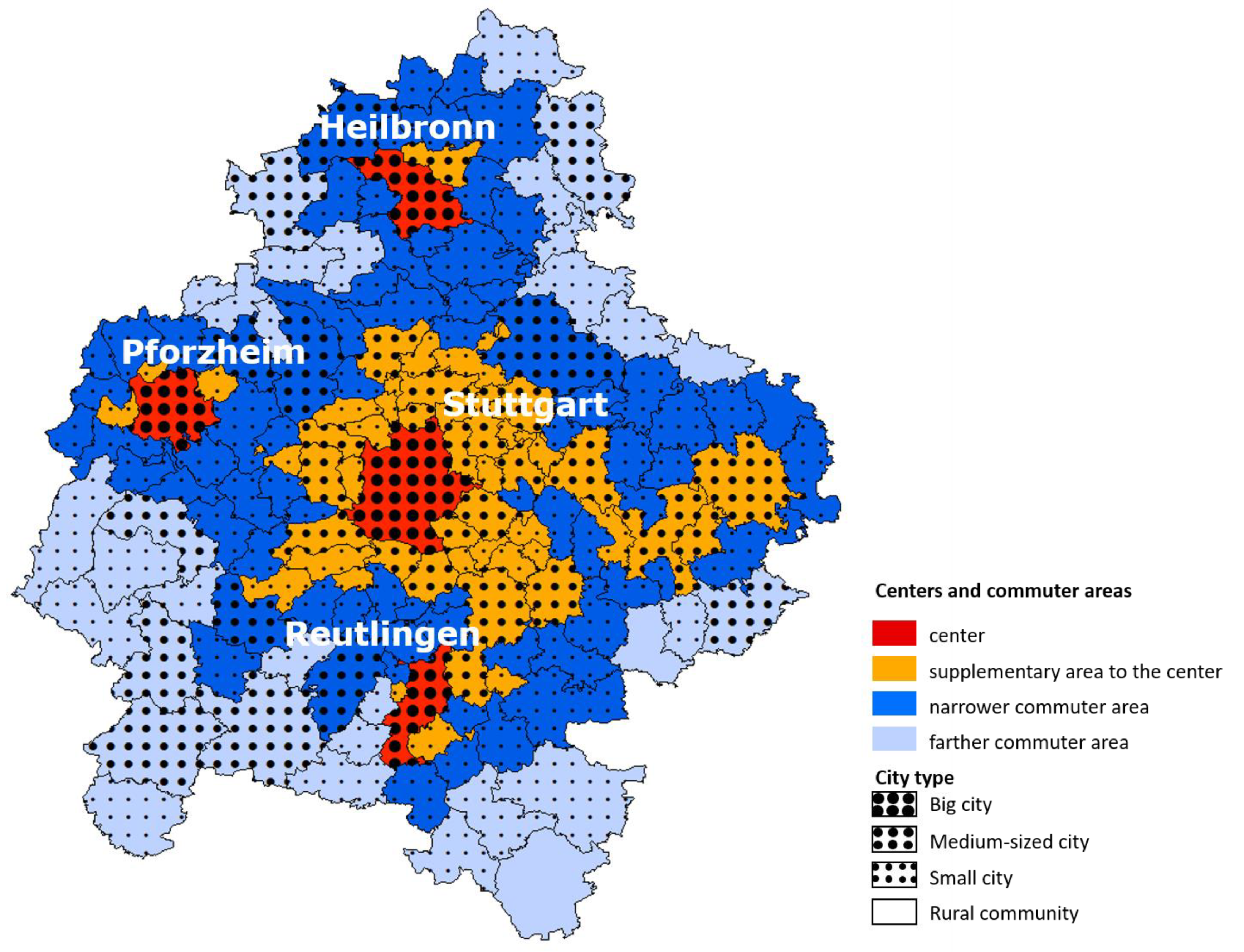

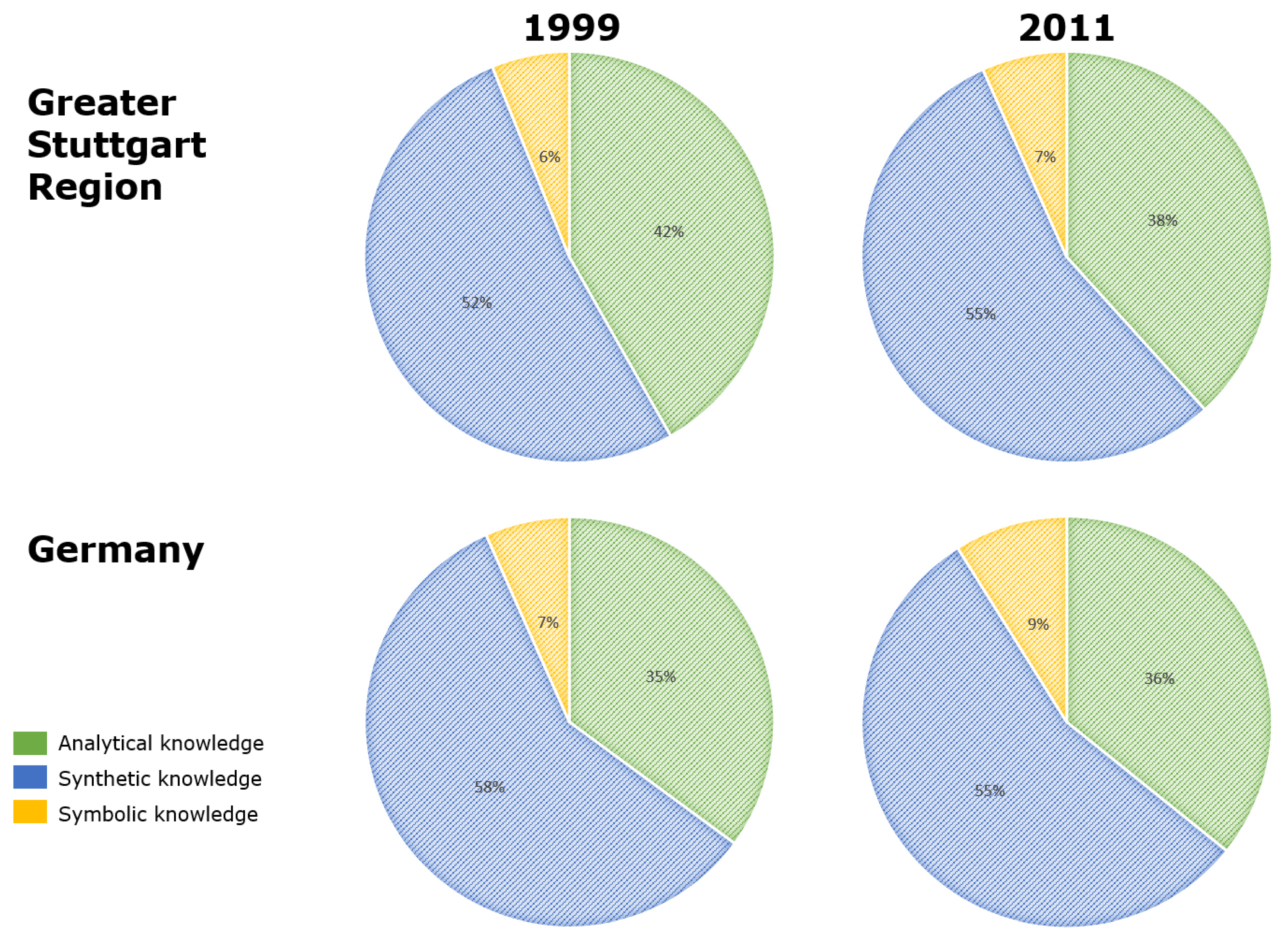

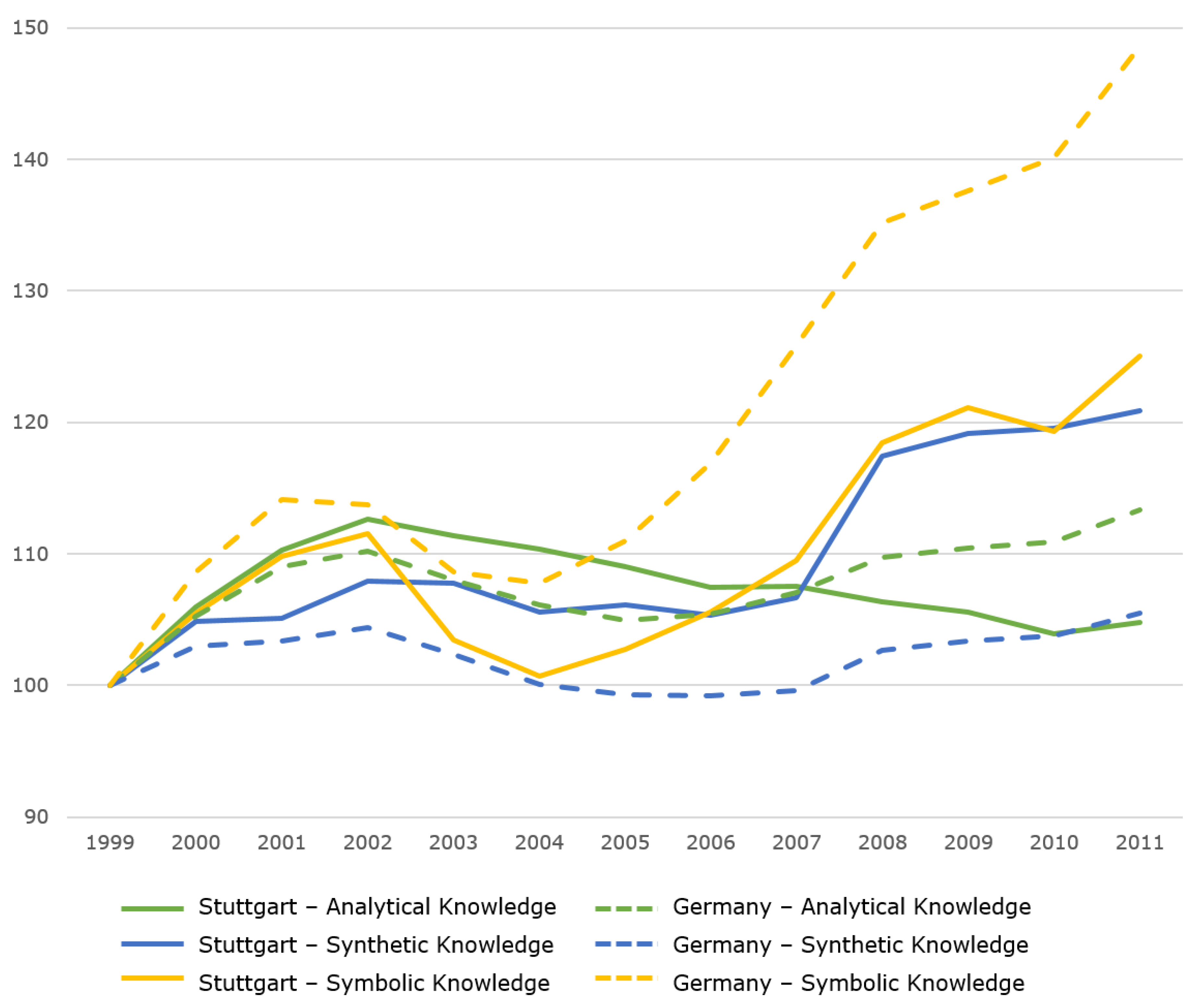
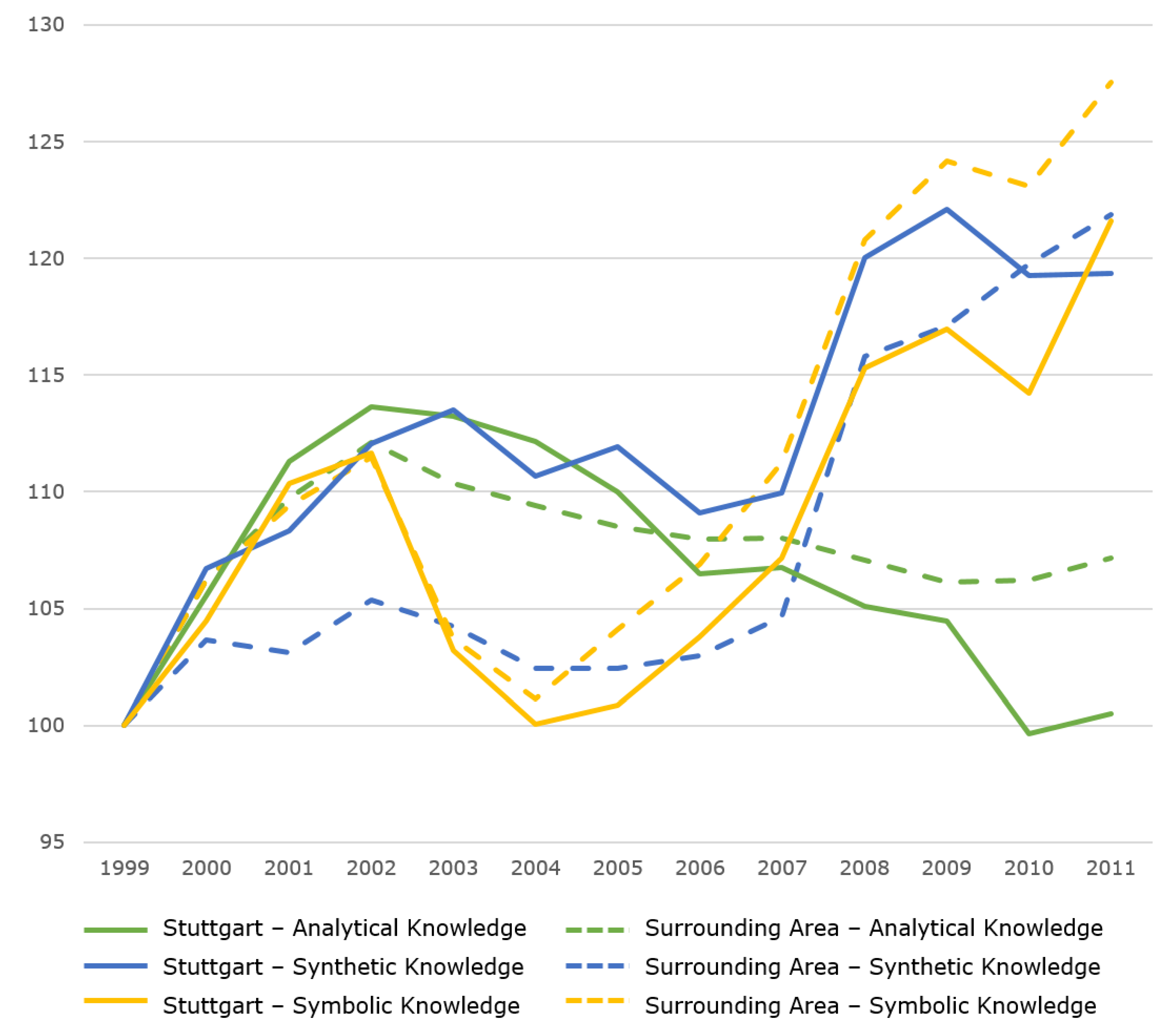
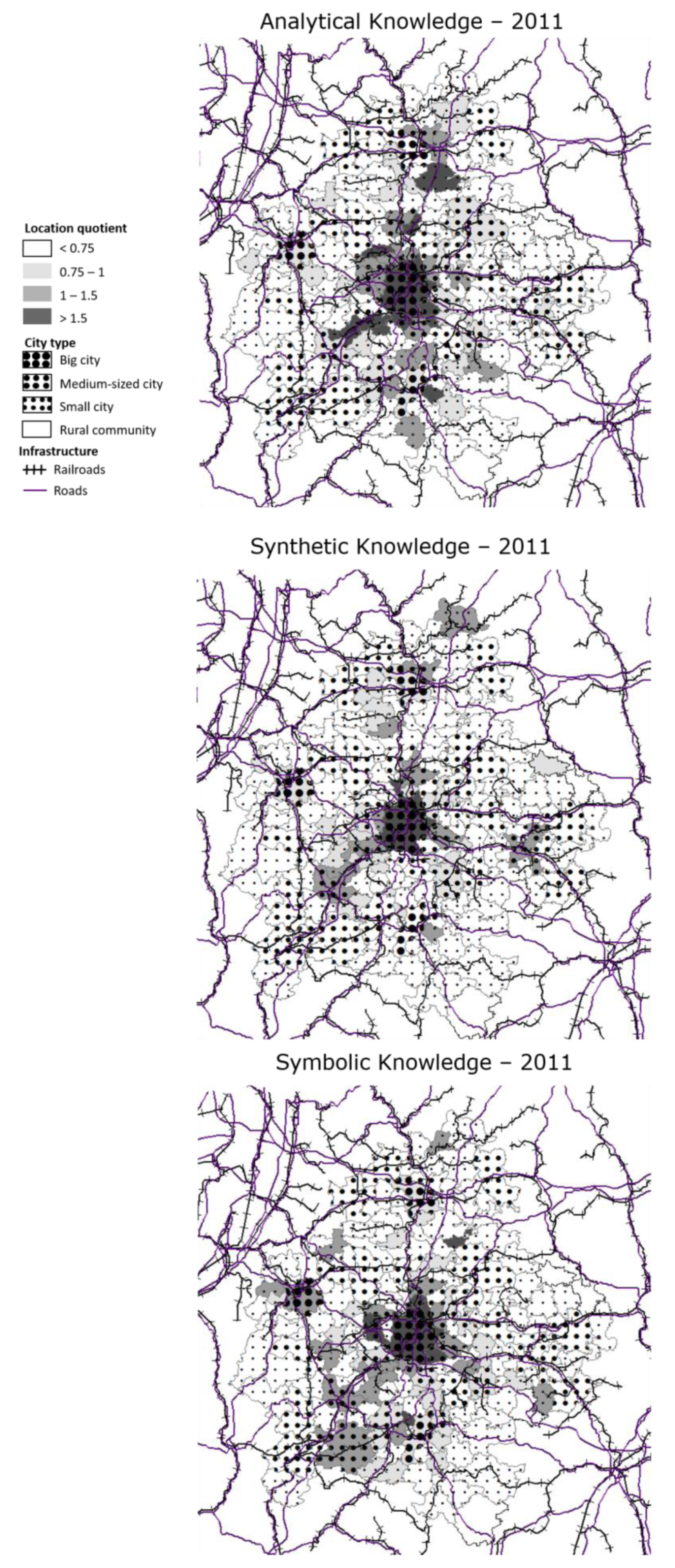
| Länder | Area (2017) | Inhabitants (2018) | Unemployment Rate (November 2019) |
|---|---|---|---|
| Bavaria | 70,542 km2 | 13,077 thousand | 2.7% |
| Lower Saxony | 47,710 km2 | 7982 thousand | 4.8% |
| Baden-Wurttemberg | 35,748 km2 | 10,070 thousand | 3.1% |
| North Rhine-Westphalia | 34,112 km2 | 17,933 thousand | 6.4% |
| Brandenburg | 29,654 km2 | 2512 thousand | 5.4% |
| Mecklenburg-Western Pomerania | 23,394 km2 | 1610 thousand | 6.7% |
| Hesse | 21,116 km2 | 6266 thousand | 4.2% |
| Saxony-Anhalt | 20,454 km2 | 2208 thousand | 6.6% |
| Rhineland-Palatinate | 19,858 km2 | 4085 thousand | 4.2% |
| Saxony | 18,450 km2 | 4078 thousand | 5.0% |
| Thuringia | 16,202 km2 | 2143 thousand | 4.9% |
| Schleswig-Holstein | 15,804 km2 | 2897 thousand | 4.9% |
| Saarland | 2571 km2 | 991 thousand | 6.0% |
| Berlin | 891 km2 | 3645 thousand | 7.6% |
| Hamburg | 755 km2 | 1841 thousand | 6.0% |
| Bremen | 419 km2 | 683 thousand | 9.8% |
| Knowledge-Intensive Service Functions | KldB 1988 Code |
|---|---|
| Accounting (ACC) | 753, 771, 772 |
| Advertising (ADV) | 703, 833, 834, 835, 837 |
| Architecture (ARC) | 603, 604, 623, 624 |
| Consulting (CON) | 752 |
| Consulting Engineering (CE) | 611, 612, 626 |
| Data Management (DM) | 774 |
| Finance (FIN) | 691, 692 |
| ICT (ICT) | 602, 622 |
| Insurance (INS) | 693, 694 |
| Law (LAW) | 811, 812, 813, 814 |
| Management (MAN) | 751 |
| Media (MED) | 821, 822 |
| Real Estate (RE) | 704 |
| Analytical Knowledge | Synthetic Knowledge | Symbolic Knowledge |
|---|---|---|
| Architecture (ARC) | Accounting (ACC) | Advertising (ADV) |
| Consulting Engineering (CE) | Consulting (CON) | Media (MED) |
| Data Management (DM) | Finance (FIN) | |
| ICT (ICT) | Insurance (INS) | |
| Law (LAW) | ||
| Management (MAN) | ||
| Real Estate (RE) |
© 2019 by the authors. Licensee MDPI, Basel, Switzerland. This article is an open access article distributed under the terms and conditions of the Creative Commons Attribution (CC BY) license (http://creativecommons.org/licenses/by/4.0/).
Share and Cite
Wagner, M.; Growe, A. Regional Urbanization and Knowledge-Intensive Business Activities (KIBS): An Example of Small and Medium-Sized Cities in the Greater Stuttgart Region (Germany). Urban Sci. 2020, 4, 1. https://doi.org/10.3390/urbansci4010001
Wagner M, Growe A. Regional Urbanization and Knowledge-Intensive Business Activities (KIBS): An Example of Small and Medium-Sized Cities in the Greater Stuttgart Region (Germany). Urban Science. 2020; 4(1):1. https://doi.org/10.3390/urbansci4010001
Chicago/Turabian StyleWagner, Madeleine, and Anna Growe. 2020. "Regional Urbanization and Knowledge-Intensive Business Activities (KIBS): An Example of Small and Medium-Sized Cities in the Greater Stuttgart Region (Germany)" Urban Science 4, no. 1: 1. https://doi.org/10.3390/urbansci4010001





